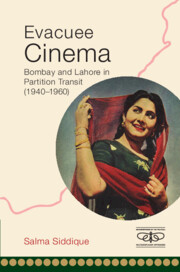Book contents
- Frontmatter
- Dedication
- Contents
- List of Figures
- Acknowledgements
- Introduction: A Moving Picture
- 1 The All-India Ambitions of Lahore
- Part 1 The Secular Stance of Bombay
- Part 2 Between Bombay and Pakistan
- Conclusion: Evacuee Cinema
- Appendix: Three Film Transcripts from the Fazli Family Collection
- Filmography
- Bibliography
- Index
Introduction: A Moving Picture
Published online by Cambridge University Press: 11 October 2022
- Frontmatter
- Dedication
- Contents
- List of Figures
- Acknowledgements
- Introduction: A Moving Picture
- 1 The All-India Ambitions of Lahore
- Part 1 The Secular Stance of Bombay
- Part 2 Between Bombay and Pakistan
- Conclusion: Evacuee Cinema
- Appendix: Three Film Transcripts from the Fazli Family Collection
- Filmography
- Bibliography
- Index
Summary
The cinema is a double-edged weapon.
Why did Khurshid and Nurjehan migrate to Pakistan?
They thought it would be better to observe purdah.
With the recent decision to ban the import of Indian films into Pakistan,
I shall miss Dilip's acting, Mehboob's direction and above all, Naushad's music.
Between Bombay and Lahore, a national fault line was drawn so darkly that it intercepted and rendered faint, existing markings of pre-national film cultures. The aforementioned fragments of disquiet in film magazines are caused by the fault line and its spectres, better known as partition. The cautionary imaging of cinema as a weapon signals a battleground of modernity. Despite its cleverness, the repartee about Khurshid and Noorjahan betrays malice at the actresses’ departure. And overarchingly, the state proscription of a public pleasure fosters a personal loss and nostalgia. Opening out South Asian film history to partition, this study recovers film narratives, film personnel and film publics coursing through the historic passage to nation states. Through the case studies of émigré personnel, this work brings forth hitherto lost or unremarked films and genres into the academic domain of Hindi–Urdu cinema.
The 1951 Report of the Film Enquiry Committee of India devotes but a short paragraph to the impact of partition on the Indian film industry:
Then came the partition and like other spheres of economic activity, the cinema industry was affected considerably. There was at first a temporary loss of a portion of the market. Disturbances in this country affected cinema earnings to some extent. Finally, the shortage of certain building materials, which were required in large quantities for housing displaced persons, led to the imposition of a ban on the construction of new cinemas in many States of the Union. In spite of these adverse factors, however, there was no drop in the production of new films.
Appearing four years after the division, the report describes loss in exclusively economic terms, an account that oscillates between emphasising the enormity of the partition and claiming its minimal impact. To a certain extent, this is symptomatic of a Janus-like approach in India to partition, which ‘as a wreckage of colonialism’ is unable to subdue the onward national march. If the Indian account is only too keen to emphasise continuity and progress, its Pakistani counterpart is equally invested in a break and an impasse.
- Type
- Chapter
- Information
- Evacuee CinemaBombay and Lahore in Partition Transit, 1940–1960, pp. 1 - 22Publisher: Cambridge University PressPrint publication year: 2023

